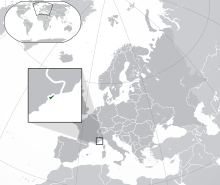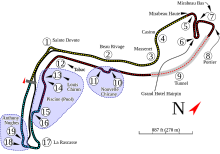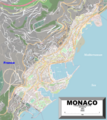Portal:Monaco
The Monaco Portal
Welcome! — Bienvenue! — Benvegnüu!

Monaco, officially the Principality of Monaco, is a sovereign city-state and microstate on the French Riviera a few kilometres west of the Italian region of Liguria, in Western Europe, on the Mediterranean Sea. It is a semi-enclave bordered by France to the north, east and west. The principality is home to nearly 39,000 residents as of the 2020s, of whom about 9,500 are Monégasque nationals. It is recognised as one of the wealthiest and most expensive places in the world. The official language of Monaco is French. Monégasque, English and Italian are also spoken and understood by many residents.
With an area of 2.08 km2 (0.80 sq mi), Monaco is the second-smallest sovereign state in the world, after Vatican City. Its population of 38,367 in 2023 makes it the most densely populated sovereign state. Monaco has the world's shortest national coastline: 3.83 km (2.38 mi). The principality is about 15 km (9.3 mi) from the border with Italy and consists of nine administrative wards, the largest of which is Monte Carlo.
The principality is governed under a form of constitutional monarchy, with Prince Albert II as head of state, who wields political power despite his constitutional status. The prime minister, who is the head of government, can be either a Monégasque or French citizen; the monarch consults with the Government of France before an appointment. Key members of the judiciary are detached French magistrates. The House of Grimaldi has ruled Monaco, with brief interruptions, since 1297. The state's sovereignty was officially recognised by the Franco-Monégasque Treaty of 1861, with Monaco becoming a full United Nations voting member in 1993. Despite Monaco's independence and separate foreign policy, its defence is the responsibility of France, besides maintenance of two small military units. (Full article...)
Selected location article

The Hôtel de Paris Monte-Carlo is a luxury hotel that is located at Place du Casino in Monte Carlo, Monaco. It was opened in 1864 as part of the development of Monaco by the Société des Bains de Mer. In March 2019, the hotel reopened after undergoing a $280 million renovation, which took more than four years to complete. (Full article...)
Selected pictures
Selected ward
Monte Carlo (/ˌmɒnti ˈkɑːrloʊ/ MON-tee KAR-loh, Italian: [ˈmonte ˈkarlo]; French: Monte-Carlo, French: [mɔ̃te kaʁlo]; or colloquially Monte-Carl, French: [mɔ̃te kaʁl]; Monégasque: Munte Carlu, Ligurian: [ˈmuŋte ˈkaɾlu]; lit. 'Mount Charles') is an official administrative area of Monaco, specifically the ward of Monte Carlo/Spélugues, where the Monte Carlo Casino is located. Informally, the name also refers to a larger district, the Monte Carlo Quarter (corresponding to the former municipality of Monte Carlo), which besides Monte Carlo/Spélugues also includes the wards of La Rousse/Saint Roman, Larvotto/Bas Moulins and Saint Michel. The permanent population of the ward of Monte Carlo is about 3,500, while that of the quarter is about 15,000. Monaco has four traditional quarters, from west to east they are: Fontvieille (the newest), Monaco-Ville (the oldest), La Condamine, and Monte Carlo.
Monte Carlo is situated on a prominent escarpment at the base of the Maritime Alps along the French Riviera. Near the quarter's western end is the "world-famous Place du Casino, the gambling center ... that has made Monte Carlo an international byword for the extravagant display and reckless dispersal of wealth". It is also the location of the Hôtel de Paris, Café de Paris and Salle Garnier (the casino theatre which is the home of the Opéra de Monte-Carlo). The quarter's eastern part includes the community of Larvotto with Monaco's only public beach, as well as its new convention center (the Grimaldi Forum), and the Monte-Carlo Bay Hotel & Resort. At the quarter's eastern border, one crosses into the French town of Beausoleil (sometimes referred to as Monte-Carlo-Supérieur), and 8 kilometres (5 mi) to its east is the western border of Italy. (Full article...)
Selected environment article

The Rock of Monaco (French: Rocher de Monaco; Monégasque: Roca de Mùnegu) is a 62-metre (203 ft) tall monolith on the Mediterranean coast of the Principality of Monaco. It overlooks the Mediterranean Sea and the Port Hercules. (Full article...)
List of articles |
|---|
Selected arts article

The Eurovision Song Contest 1976 was the 21st edition of the annual Eurovision Song Contest. It took place in The Hague, Netherlands, following the country's victory at the 1975 contest with the song "Ding-a-dong" by Teach-In. Organised by the European Broadcasting Union (EBU) and host broadcaster Nederlandse Omroep Stichting (NOS), the contest was held at the Nederlands Congrescentrum on 3 April 1976 and was hosted by 1957 Dutch Eurovision winner Corry Brokken.
Eighteen countries took part in the contest with Sweden, Malta and Turkey opting not to return to the contest after participating the previous year. Malta would not return to the contest again until 1991. On the other hand, Austria and Greece returned to the competition, having been absent since 1972 and 1974 respectively. (Full article...)
Selected religion article

The history of the Jews in Monaco goes back at least a century, most notably to the time of the Holocaust. Monaco had a very small Jewish presence before World War II, numbering approximately 300 people. During the war, the principality's government issued false identity papers to its Jewish residents to protect them from Nazi deportation. Prince Louis II refused to dismiss Jewish civil servants and protected Édouard de Rothschild from deportation. However, Monaco's police arrested and turned over 42 Central European Jewish refugees to the Nazis. Sixty Jews were arrested 27–28 August 1942, and ninety in total, according to The Algemeiner.
In 1948, the Association Cultuelle Israelite de Monaco was founded as the official organization of Monaco's Jewish community, and it provides the community with a synagogue, Hebrew school and no kosher food store, but a kosher section in some supermarkets. Today's Jewish community in Monaco consists primarily of retirees from France and the United Kingdom, and there is also a small population of North African and Turkish Jews. More Sephardic Jews came when they were expelled from countries like Morocco, Algeria, Tunisia, Yemen, and South America/ Spain. To them, Monaco and France were alternatives to Israel. (Full article...)
Selected sports article

The 2000 Monaco Grand Prix (formally the LVIII Grand Prix Automobile de Monaco) was a Formula One motor race held on 4 June 2000 at the Circuit de Monaco. It was the seventh round of the 2000 Formula One World Championship and the 58th Monaco Grand Prix. McLaren driver David Coulthard won the 78-lap race starting from third position. Rubens Barrichello finished second for the Ferrari team with Benetton's Giancarlo Fisichella third.
World Drivers' Championship leader Michael Schumacher driving for World Constructors' Championship leaders Ferrari started from pole position alongside Jordan driver Jarno Trulli after recording the quickest qualifying lap time. The race was stopped due to a software glitch in the starting procedure and a collision between Jenson Button and Pedro de la Rosa that created a traffic jam. Michael Schumacher led into the first corner of the second start. After the second round of pit stops, Michael Schumacher's exhaust failed, resulting in a left rear suspension failure and his retirement from the race. On lap 56, Coulthard, who was running in second place, took the lead. Coulthard took the win, his second of the season and ninth in Formula One, with Barrichello a further 15.8 seconds back. (Full article...)
Selected education article
The American College of Monaco was a tertiary institution located in Monte Carlo, Monaco. It operated from 1968 until 1970. The college offered a four-year degree program and was reportedly established by the Principality at the request of Princess Grace. (Full article...)
Selected transportation article

Port Hercules (French: Port Hercule [pɔʁ ɛʁkyl]) is the only deep-water port in Monaco. The port has been in use since ancient times. The modern port was completed in 1926, and underwent substantial improvements in the 1970s. It covers almost 40 acres (160,000 m2), enough to provide anchorage for up to 700 vessels. The port is located in the La Condamine district. Harbour pilots are required for all vessels longer than 30 metres. The depth of water in the harbour ranges from seven metres for standard berths and up to 40 metres for the outer piers and cruise ship docks. (Full article...)
Selected biography
Maurice Revelli (born 4 September 1964) is a Monegasque former professional footballer who played as a defender. (Full article...)
Related portals
Need help?
Do you have a question about Monaco that you can't find the answer to?
Consider asking it at the Wikipedia reference desk.
Categories
Get involved
For editor resources and to collaborate with other editors on improving Wikipedia's Monaco-related articles, see WikiProject Monaco.
Topics
Associated Wikimedia
The following Wikimedia Foundation sister projects provide more on this subject:
 Commons
Commons
Free media repository Wikibooks
Wikibooks
Free textbooks and manuals Wikidata
Wikidata
Free knowledge base Wikinews
Wikinews
Free-content news Wikiquote
Wikiquote
Collection of quotations Wikisource
Wikisource
Free-content library Wikiversity
Wikiversity
Free learning tools Wikivoyage
Wikivoyage
Free travel guide Wiktionary
Wiktionary
Dictionary and thesaurus


























































